James H. Tsai, retired
University of Florida
Fort Lauderdale Research and Education Center
3205 College Ave.
Fort Lauderdale, FL 33314
Introduction
Citrus is one of the most economically important crops in the U.S. with nearly 500,000 ha in citrus groves in California, Florida, Texas and Arizona. In Florida there are 342,105 ha of citrus groves with an annual earning of about $1.1 billion (Anonymous, 2000.) Like many other crops, citrus is plagued with a host of diseases caused by different etiological agents such as fungi, bacteria, viruses and phytoplasmas. Of all diseases of citrus described to date, citrus greening disease, also known as Huanglongbing or Likubin in Chinese, is considered probably the most destructive and lethal disease of citrus. Two forms of greening disease are currently known (Bové et al. 1974). One is a heat-sensitive type which is found in the southern part of Africa. When the temperature reaches above 30ºC for several hours a day, the symptoms fail to develop. The other form is heat-tolerant and is predominantly distributed in Asia and Saudi Arabia. The heat-sensitive bacterium is transmitted by the African citrus psyllid, Trioza erytreae (del Guercio) whereas the heat-tolerant bacterium is transmitted by the Asian citrus psyllid, Diaphorina citri Kuwayana.
Bionomics of Asian Citrus Psyllid
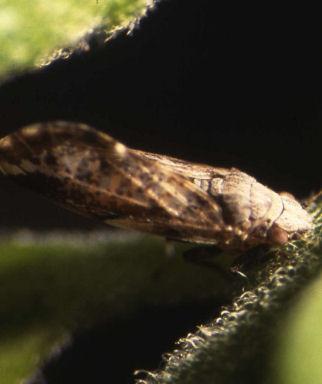
The Asian citrus psyllid (D. citri) is a member of Sternorrhyncha: Psyllidae. It is considered a serious pest of citrus in the world due to its ability to efficiently transmit the greening agent. However, in the absence of citrus greening agent, this insect is usually a minor pest. This insect was first found in southern Florida in June 1998 and has since spread throughout the state (Halbert et al. 2002, Tsai and Liu 2000). The possible route of Florida introduction could be: 1) This insect has been in South America for many years; thus it could have moved through Central America and the Caribbean. From there it was carried northward by seasonal trade wind or hurricane storm similar to the introduction of the tropical corn pathogens and their insect vectors in the 1970s (Bradfute et al. 1981). 2) The other possibility is that D. citri could have been introduced with infested plants from Asia or South America.
Diaphorina citri is of known Far Eastern origin (Mead 1977). It is found in all of southeast Asia and the Indian subcontinent, the islands of Reunion and Mauritius, Saudi Arabia, Brazil, Iran, Venezuela, Argentina and Guadeloupe (Cermeli et al. 2000, da Graça 1991, Etienne et al. 1998, Halbert and Manjunath 2004, Mead 1977).
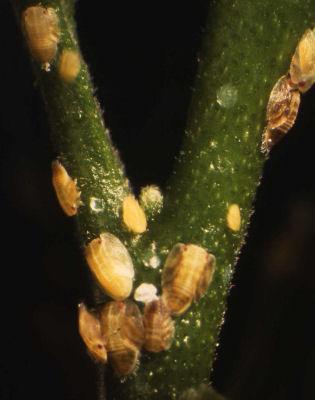
Liu and Tsai (2000) studied the development, survivorship, longevity, reproduction, and life table parameters of D. citri at 10ºC, 15ºC, 20ºC, 25ºC, 28ºC, 30ºC and 33ºC. The populations reared at 10ºC and 33ºC failed to develop. Between 15ºC and 30ºC, mean developmental period from egg to adult varied from 49.3 days at 15ºC to 14.1 days at 28ºC. The low-temperature developmental thresholds for 1st through 5th instars were estimated at 11.7ºC, 10.7ºC, 10.1ºC, 10.5ºC and 10.9C respectively. The survival of the 3rd through 5th nymphal instars at 15-28ºC was essentially the same. The mean longevity of females increased with decreasing temperature within 15-30ºC. The maximal longevity of individual females was recorded 117, 60, 56, 52 and 51 days at 15ºC, 20ºC, 25ºC, 28ºC and 30ºC, respectively. The average number of eggs produced per female significantly increased with increasing temperature and reached a maximum of 748.3 eggs at 28ºC (P <0.001). The population reared at 28ºC had the highest intrinsic rate of increase (0.199) and net reproductive rate (292.2); and the shortest population doubling time (3.5 days) and mean generation time (28.6 days) compared with populations reared at 15-25ºC. The optimum range of temperatures for D. citri population growth was 25-28ºC.
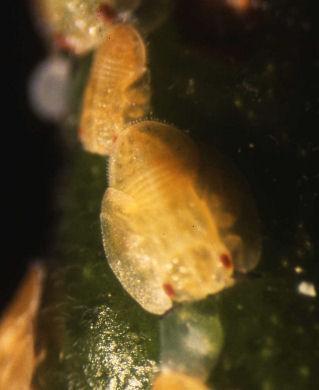
Life table parameters on three commonly grown citrus [rough lemon (Citrus jambhiri Lush), sour orange (C. aurantium L.), grapefruit (C. paradsi Macfadyen)] and a non-citrus, orange Jessamine (Murraya paniculata (L.) Jack) have also been studied for Florida D. citri. The average egg incubation periods on orange Jessamine, grapefruit, rough lemon and sour orange varied very little (4.1-4.2 days). The average nymphal developmental periods on these four host plants were essentially the same except the fifth stadium. Survival of immatures on orange Jessamine, grapefruit, rough lemon and sour orange was 75.4, 84.6, 78.3 and 68.6% respectively. Female adults lived an average of 39.7, 39.7, 47.6 and 43.7 days on these respective host plants. The average number of eggs laid per female on grapefruit (856 eggs) was significantly more than those on other hosts (P <0.05). The intrinsic rate of natural increase (rm) for D. citri on grapefruit was highest. The mean population generation time on these hosts ranged from 31.6 to 34.1 days (Tsai and Liu 2000). Besides the size differences, the morphological characteristics of each nymphal stage and field detection were also described (Tsai and Liu 2000), (Figs. 1, 2, 3, 4, and 5). There are at least 56 species of plants including many of the close citrus relatives as hosts of D. citri (Halbert and Manjunath 2004). In southern Florida, psyllid populations were positively related to the availability of new shoot flushes which were in turn related to the weekly minimum temperature and rainfall (Tsai et al. 2002).
Biology of Citrus Greening Agents
The greening agents are fastidious phloem-restricted Gram-negative bacteria in the Genus Candidatus Liberibacter of the Graciticutes. The Asian form, a heat tolerant, is named L. asiaticus and L. africanum for the heat sensitive (African) form on the basis of sequence homology (Garnier et al. 2000, Planet et al. 1995). The African citrus greening develops symptoms only under cool conditions (20-25ºC) whereas the Asian greening develops symptoms under both cool and warm (up to 35ºC) conditions. The Asian citrus greening is thought to have originated in southern China (Lin and Lin 1990) and was first reported in China in 1943 (Lin 1956), Tsai et al. 1988) and in Taiwan in 1951 (Su and Huang 1990, Su and Hung 2001).
Early symptoms on a greening infected citrus produce a leaf yellowing on a single shoot or branch which is descriptive for the Chinese name of yellow dragon (Fig 6). Infected leaves show a mottled or blotchy appearance (Fig. 7) at the initial stage of symptom development. The yellowing spreads to other parts of the tree and dieback (Fig. 8) and rapid decline follow. At the advanced stage, the leaves are small and often display symptoms similar to zinc or manganese deficiency. Fruits from the infected trees are underdeveloped, unevenly shaped and remain green, thus the name greening disease.
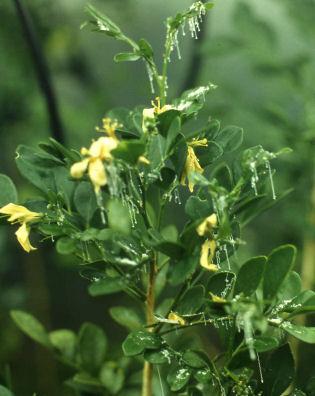
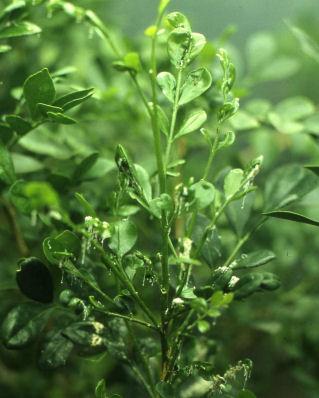
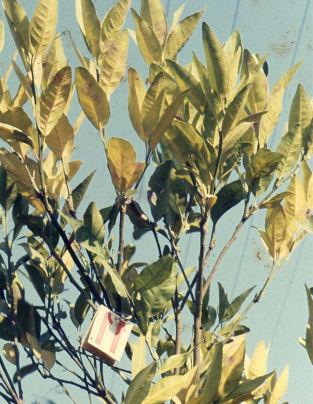
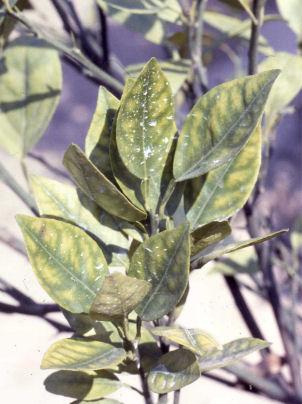
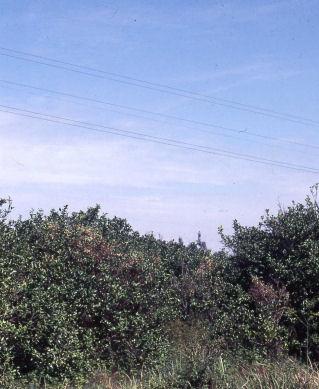
Infected trees die within 3-5 years. Infected orange (C. sinensis), mandarin (C. reticulata) and tangelo (C. reticulate x C. paradsi) produce the most severe symptoms. Most citrus cultivars (varieties) are susceptible to the Asian citrus greening. However, it is assumed that at least four isolates (strains) of Asian citrus greening agent have been noted in Taiwan (Su and Hung 2001). Citrus greening bacterium has been experimentally transmitted from the infected citrus to periwinkle (Cathoranthus roseus), a non-rutaceous host by means of dodder (Cuscuta campestris) (Garnier and Bové 1993, Ke et al. 1988).
The causal agents of citrus greening are transmitted by the psyllid vectors and graft inoculation. Graft transmission was first reported in China in the 1950s (Lin 1956). Although T. erytreae is the natural vector of African citrus greening and D. citri is the natural vector of Asian citrus greening, either psyllid vector can transmit both greening agents under experimental conditions (Lallemand et al. 1986, Massonie et al. 1976). However, it is not known if either vector can be infected simultaneously by both bacteria (Garnier et al. 1996). Vector transmission is the primary means of spread in the field. The minimum acquisition feeding period for D. citri to acquire the greening agent ranges from 30 min. to 5-7 hours and the minimum incubation period in the vector ranged from 1-25 days (Roistacher 1991, Xu et al. 1988). Graft transmission of the citrus greening agent varies with the plant part, the amount of tissue and the pathogen strain (Lin and Lin 1990, Van Vuuren 1993).
In recent years several accurate diagnostic techniques have been developed. Strain specific DNA probes and PCR are now commonly used to detect the citrus greening agents both in psyllid vectors and in infected plants (Bové et al. 1993, Su and Hung 2001, Tian et al. 1996). The immunofluorescence technique using monoclonal antibodies has been developed for detection of different isolates (strains) of citrus greening agent (Garnier et al. 1987). At least 42 species of citrus and non-citrus plants are known as natural or experimental hosts of citrus greening agents (Halbert and Manjunath 2004).
Prior to finding the citrus greening agent in symptomatic citrus plants in Florida, the D. citri vector had become well established throughout the state. Therefore, an eradication program was never initiated. Currently, only the movement of all potential hosts of citrus greening agent or D. citri outside of the quarantine counties is prohibited.
Several reports have emphasized the importance of psyllid control with pesticides, especially during the flush period (Aubert 1987, Gonzales and Vinas 1981, Roistacher 1996, Su et al. 1986). With the exception of using neem extracts to control psyllid vector with a good result (Shivankar et al. 2000), there is no information on the availability of environmentally friendly pesticides for citrus psyllid control. In India, trunk injection of antibiotics has been used as part of an integrated management program (Nariani 1981). Treating budwood with tetracycline hydrochloride solution has been practiced in China (Zhao 1981).
Utilization of biocontrol agents yields promising results. Two fungal pathogens, Cladosporium sp. nr. oxysporum Berk and M.A. Curtis and Capnodium citri Mont. Are known to cause high nymphal mortality in D. citri under high relative humidity conditions (Aubert 1987). One ectoparasite, Tamarixia radiata (Weterston) and one endoparasite, Diaphorencyrtus aligarhensis (Shaffee et al.) are effective primary parasites of D. citri, but their effectiveness can be greatly affected by hyperparasitism (Aubert 1987, Garnier and Bové 1993). Both parasites have been introduced in Florida with limited success, but only T. radiata is established in Florida (McFarland and Hoy 2001, Michaud 2002). Routine removal of symptomatic branches and trees and planting barrier windbreaks have been practiced in China (Ke and Xu 1990).
Like any other perennial woody trees affected by a vectored pathogen, citrus greening disease is very complex and difficult to manage. Currently, the most feasible and workable management practices in China and Taiwan include the use of certified greening free nursery stock, psyllid control and removing sources of inoculum (Hung et al. 2000, Ke and Xu 1990, Su et al. 1986).
Citrus greening is becoming a global problem threatening the very survival of the citrus industry in every citrus producing country. Considerable progress has been made in the study of the dynamics, epidemiology, and molecular characteristics of the causal pathogens of citrus greening disease, but vector-pathogen-plant relationships are still not well understood. It must be hoped that this problem will attract the attention of decision makers from resource rich countries so that more resources are committed to research on molecular aspects of cross protection and genetic breeding and thereby provide a long term solution to this serious problem.
References
- Anonymous. 2000. Citrus summary 1998-1999. Florida Agricultural Statistics Service. Florida Department of Agriculture and Consumer Services. 48pp.
- Aubert, B. 1987. Trioza erytreae del Guercio and Diaphorina citri Kuwayama (Homopera: Psylloidea), the two vectors of citrus greening disease: Biological aspects and possible control strategies. Fruits 42: 149-162.
- Bové, J. M., E.D. Calavan, S. P. Capoor, R. E. Cortez, and R. E. Schwarz. 1974. Influence of temperature on symptoms of California stubborn, South African greening, Indian citrus decline and Phillippine leaf mottling disease. Pp. 12-15. In L. G. Weathers and M. Cohen [eds.], Proc. 6th Conference of the International Organization of Citrus Virologists(IOCV). University of California, Riverside.
- Bové, J. M., M. Garnier, Y. S. Ahlawat, N. K. Chakraborty, and A. Varma. 1993. Detection of the Asian strains of the greening BLO by DNA-DNA hybridization in Indian orchard trees and Malaysian Diaphorina citri psyllids, pp. 258-263 In P. Moreno, J. V. da Graça, and L. W. Timmer [eds.], Proc. 12th Conference of the International Organization of Citrus Virologists (IOCV). University of California, Riverside.
- Bradfute, O.E., J.H. Tsai and D.T. Gordon. 1981. Corn stunt spiroplasma and viruses associated with a maize epidemic in southern Florida. Plant Disease 65: 837-841.
- Cermeli, M., P. Morales, and F. Godoy. 2000. Presencia del pailido asiático de los citricos Diaphorina citri Kuwayama (Hemiptera: Psyllidae) en Venezuela. Boletin Entomologia Venezolana 15: 235-243.
- Da Graca, J. V. 1991. Citrus greening disease. Annu. Rev. Phytopathology 29: 109-136.
- Étienne, J., D. Burckhardt, and C. Grapin. 1998. Diaphorina citri ;(Kuwayama) (sic) en Guadeloupe, premier signalement pour les caraïbes (Hem., Psyllidae). Bulletin de la Société Entomologique de France 103: 32.
- Garnier, M., and J. M. Bové. 1993. Citrus greening disease, pp. 212-219 In P. Moreno, J. V. da Graça, and L. W. Timmer [eds.], Proc. 12th Conference of the International Organization of Citrus Virologists (IOCV). University of California, Riverside.
- Garnier, M., S. Jagoueix-Eveillard, P. R. Cronje, G. F. LeRoux, and J. M. Bové. 2000. Genomic characterization of a Liberibacter present in an ornamental rutaceous tree, Calodendrum capense, in the Western Cape Province of South Africa. Proposal of 'Candidatus Liberibacter africanus subsp. capensis.' International Journal of Systematic and Evolutionary Microbiology 50: 2119-2125.
- Garnier, M., S. Jagoueix, P. Toorawa, M. Grisoni, R. Mallessard, A. Dookun, S. Saumtally, J. C. Autrey, and J. M. Bové. 1996. Both huanglongbing (greening) Liberobacter species are present in Mauritius and Réunion, pp. 392-398 In J. V. da Graça, P. Moreno, and R. K. Yokomi [eds.], Proc. 13th Conference of the International Organization of Citrus Virologists (IOCV). University of California, Riverside.
- Garnier, M., Martin-Gros, and J. M. Bové. 1987. Monoclonal antibodies against the bacterial-like organism associated with citrus greening disease. Ann. Microbiol. (Inst. Pasteur) 138: 639-650.
- Gonzales, C. I., and R. C. Vinas. 1981. Field performance of citrus varieties and cultivars grown under sonctrol measures adopted against leaf mottling (greening) disease in the Philippines. Proc. International Soc. Citriculture 1: 463-464.
- Halbert, S. E., C. L. Niblett, K. L. Manjunath, R. F. Lee, and L. G. Brown. 2002. Establishment of two new vectors of citrus pathogens in Florida. Proc. International Soc. Citriculture IX Congress, ASHS Press, Alexandria, VA. pp 1016-1017.
- Halbert, S. E. and K. L. Manjunath. 2004. Asian citrus psyllids (Sternorrhyncha: Psyllidae) and greening disease of citrus: A literature review and assessment of risk in Florida. Florida Entomol. 87: 330-353.
- Hung, T. H., M. L. Wu, and H. J. Su 2000. Identification of alternative hosts of the fastidious bacterium causing citrus greening disease. J. Phytopathol. 148:321-326.
- Ke, S., K. B. Li, C. Ke, and J. H. Tsai. 1988. Transmission of the Huanglongbin agent from citrus to periwinkle by dodder. pp 258-264 In S. M. Garnsey and L. N. Timmer (eds.) Proc. 10th Conference of the International Organization of Citrus Virologists.
- Ke, C., and C.-F. Xu. 1990. Successful integrated management of huanglongbing disease in several farms of Guangdong and Fujian by combining early eradication with targeted insecticide spraying, pp. 145-148. In B. Aubert, S. Tontyaporn, and D. Buangauwon (eds.), Proc. 4th International Asia Pacific Conference on Citrus Rehabilitation. FAO-UNDP.
- Lallemand, J., A. Fos, and J. M. Bové. 1986. Transmission de la bacterie associé à la forme africaine de la maladie du “greening” par le psylle asiatique Diaphorina citri Kuwayama. Fruits 41: 341-343.
- Lin, K. H. 1956. Observation on yellow shoot on citrus. Etiological studies of yellow shoot on Citrus. Acta Phytopathological Sinica 2:1-42.
- Lin, K.-Hsiang and K.-Hsun Lin. 1990. The citrus huang lung bin (greening) disease in China, pp. 1-26 In B. Aubert, S. Tontyaporn, and D. Buangsuwon [eds.], Rehabilitation of Citrus Industry in the Asia Pacific Region. Proc. Asia Pacific International Conference on Citriculture, Chiang Mai, Thailand, 4-10 February 1990. UNDP-FAO. Rome.
- Liu, Y. H., and J. H. Tsai. 2000. Effects of temperature on biology and life table parameters of the Asian citrus psyllid, Diaphorina citri Kuwayama (Homoptera: Psyllidae). Ann. Applied Biol. 137:210-216.
- Massonie, G., M. Garnier, and J. M. Bové. 1976. Transmission of Indian citrus decline by Trioza erytreae (Del Guercio), the vector of South African greening, pp. 18-20 In E. C. Calavan [ed.], Proc. 7th Conference of the International Organization of Citrus Virologists. IOCV, Riverside, CA.
- McFarland, C. D., and M. A. Hoy. 2001. Survival of Diaphorina citri (Homoptera: Psyllidae), and its two parasitoids, Tamarixia radiata (Hymenoptera: Eulophidae) and Diaphorencyrtus aligarhensis (Hymenoptera: Encyrtidae), under different relative humidities and temperature regimes. Florida Entomol. 84: 227-233.
- Mead, F. W. 1977. The Asiatic citrus psyllid, Diaphorina citri Kuwayama (Homoptera: Psyllidae). Entomology Circular 180. Florida Department of Agriculture and Consumer Services, Division of Plant Industry. 4 pp.
- Michaud, J. P. 2002. Biological control of Asian citrus psyllid, Diaphorina citri (Hemiptera: Psyllidae) in Florida: A preliminary report. Entomological news 113:216-222.
- Nariani, T. K. 1981. Integrated approach to control citrus greening disease in India. Proc. International Soc. Citriculture 1: 471-472.
- Planet, P., S. Jagoueix, J. M. Bové, and M. Garnier. 1995. Detection and characterization of the African citrus greening liberobacter by amplification, cloning, and sequencing of the rpl-KAJL-rpoBC operon. Current Microbiology 30: 137-141.
- Roistacher, C. N. 1991. Techniques for biological detection of specific citrus graft transmissible diseases, pages 35-45 (Greening). FAO, Rome. 286 pp.
- Roistacher, C. N. 1996. The economics of living with citrus diseases: Huanglongbing (greening) in Thailand, pp. 279-285 In J. V. da Graça, P. Moreno, and R. K. Yokomi [eds.], Proc. 13th Conference of the International Organization of Citrus Virologists (IOCV). University of California, Riverside.
- Shivankar, V. J., C. N. Rao, and S. Singh. 2000. Studies on citrus Psylla, Diaphorina citri Kuwayama: A review. Agricultural Reviews (Karnal, India) 21: 199-204.
- Su, H.-J. and R.-S Huang. 1990. The nature of likubin organism, life cycle, morphology and possible strains, pp. 106-110 In B. Aubert, S. Tontyaporn, and D. Buangsuwon [eds.], Rehabilitation of Citrus Industry in the Asia Pacific Region. Proc. Asia Pacific International Conference on Citriculture. Chiang Mai, Thailand, 4-10 February 1990. UNDP-FAO, Rome.
- Su, H. J. and T. H. Hung. 2001. Detection of greening fastidious bacteria (GFB) causing citrus greening by dot hybridization and polymerase chain reaction (PCR) with DNA probes and primer pairs FFTC/ASPAC, Taipei, Taiwan. 5 pp.
- Su, H. J., J. U. Cheon, and M. J. Tsai. 1986. Citrus greening (Likubin) and some viruses and their control trials. Pp. 143-147. In Plant Virus Diseases of Horticultural Crops in the Tropics and Subtropics. FFTC Book Series No. 33.
- Tian, Y., S. Ke, and C. Ke. 1996. Polymerase chain reaction for detection and quantitation of Liberobacter asiaticum, the bacterium associated with huanglongbing (greening) of citrus in China, pp. 252-257 In J. V. da Graça, P. Moreno, and R. K. Yokomi [eds.], Proc. 13th Conference of the International Organization of Citrus Virologists (IOCV). University of California, Riverside.
- Tsai, J. H., Z. Y. Chen, C. Y Chen, and K. X. Jin. 1988. Mycoplasmas and fastidious vascular prokaryotes associated with tree diseases in China. pp 69-97. In C. Hiruki (ed.). Tree mycoplasmas and mycoplasma diseases. The University of Alberta Press.
- Tsai, J. H., and Y. H. Liu. 2000. Biology of Diaphorina citri (Homoptera: Psyllidae) on four host plants. J. Econ. Entomol. 93: 1721-1725.
- Tsai, J. H., J. J. Wang and Y. H. Liu. 2002. Seasonal abundance of the Asian citrus psyllid, Diaphorina citri (Homoptera: Psyllidae) in southern Florida. Florida Entomol. 87: 446-451.
- Van Vurren, S. P. 1993. Variable transmission of African greening to sweet orange, pp. 264-268 In P. Moreno, J. V. da Graça, and L. W. Timmer (eds.) Proc. 12th Conference of the International Organization of Citrus Virologists (IOCV). University of California, Riverside.
- Xu, C.-F., Y.-H. Xia, K.-B. Li, and C. Ke. 1988. Further study of the transmission of citrus hanglungbin by a psyllid, Diaphorina citri Kuwayama, pp. 243-248 In L. W. Timmer, S. M. Garnsey, and L. Navarro (eds.), Proc. 10th Conference of the International Organization of Citrus Virologists (IOCV). Riverside, CA.
- Zhao, X.-Y. 1981. Citrus yellow shoot disease (huanglongbing) in China -- a review. Proc. International Soc. Citriculture 1: 466-469.